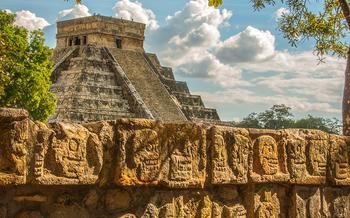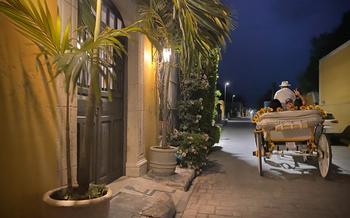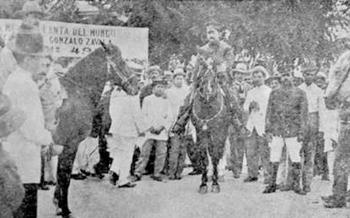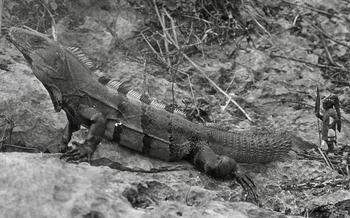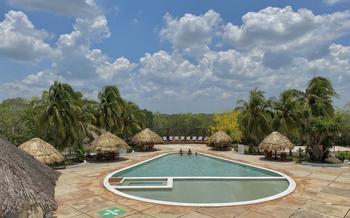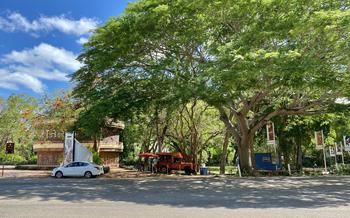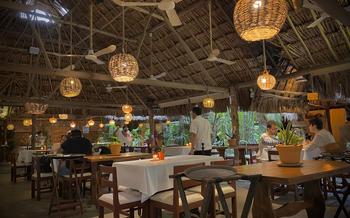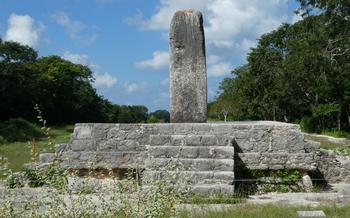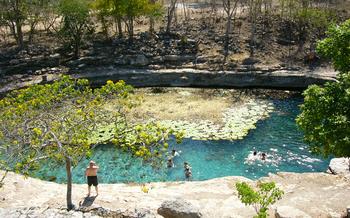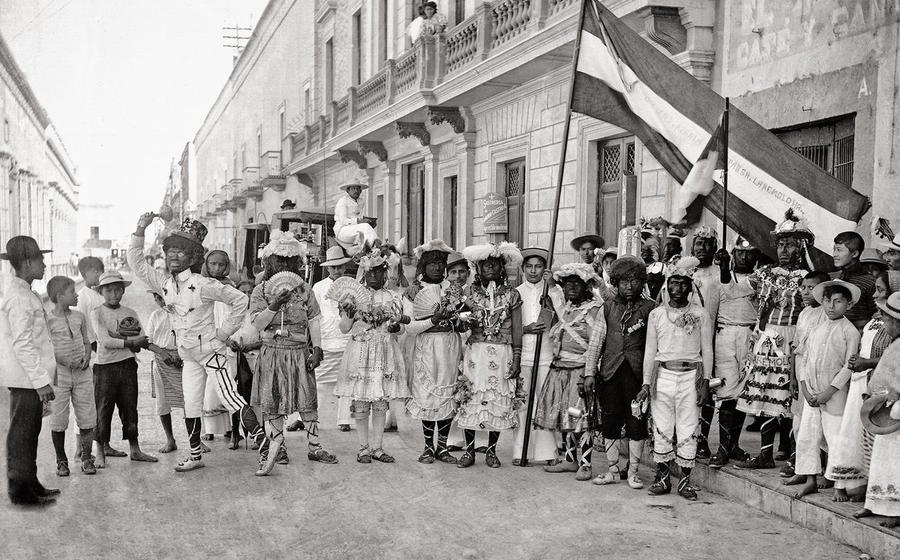
Cenote Kankabchen
- Delve into the History and Geological Formation of Cenote Kankabchen
- Location and Accessibility:
- Natural Beauty and Scenery: A Paradise Unveiled
- Diving and Exploration
- Cultural and Historical Significance
- Photography and Videography:
- Local Cuisine and Dining:
- Sustainable and Eco-friendly Practices:
- Local Accommodation Options:
- Guided Tours and Excursions
- Wildlife and Biodiversity
- Best Time to Visit:
- Packing Essentials:
Delve into the History and Geological Formation of Cenote Kankabchen
History and Geological Formation:
Cenote Kankabchen, a natural wonder located in the heart of the Yucatán Peninsula, offers a glimpse into the region's rich geological history and cultural heritage. Formed millions of years ago by the collapse of limestone bedrock, this ancient cenote is a testament to the power of nature's artistry. Its captivating beauty lies in its crystal-clear turquoise waters, surrounded by lush vegetation and unique rock formations, creating a breathtaking spectacle that draws visitors from around the world.
Spiritual Significance:
For the ancient Maya, cenotes held a profound spiritual significance. They believed these natural pools were portals to the underworld, known as Xibalba, and served as sacred places for religious ceremonies and rituals. Cenotes were considered gateways to communicate with the gods, seek guidance, and honor the spirits of their ancestors. The Maya revered cenotes as sources of life and fertility, offering reverence to their mystical and spiritual qualities.
Personal Anecdote:
My first encounter with Cenote Kankabchen was an awe-inspiring experience. As I descended the stone steps leading to the water's edge, I was greeted by a symphony of natural beauty. The vibrant turquoise hue of the water contrasted with the lush green foliage, creating a captivating tapestry of colors. The air was filled with the gentle sound of dripping water, adding a serene ambiance to the tranquil setting. I couldn't resist diving into the crystal-clear waters, immersing myself in the refreshing embrace of the cenote. As I floated effortlessly, surrounded by the beauty of nature, I felt a profound connection to the ancient Maya and their reverence for these sacred pools.
Location and Accessibility:
Cenote Kankabchen is located approximately 20 miles (32 kilometers) southwest of Mérida, the capital city of Yucatán, Mexico. To reach the cenote, you can either drive or take public transportation. If driving, follow the signs from Mérida to the town of Tekit. Once in Tekit, ask for directions to the cenote, which is located just a few miles outside of town.
Public transportation is also an option, but it is less direct. Take a bus from Mérida to Tekit, and then transfer to a local bus or taxi to reach the cenote. The entrance fee to Cenote Kankabchen is $10 USD, and it is open to visitors from 9 am to 5 pm daily. No special permits or requirements are needed to visit the cenote, but it is advisable to bring water shoes or sandals for walking on the slippery rocks.
Natural Beauty and Scenery: A Paradise Unveiled
Cenote Kankabchen boasts a breathtaking landscape that will leave you spellbound. Imagine crystal-clear turquoise waters, so clear that you can see every pebble and fish swimming beneath the surface. The lush vegetation surrounding the cenote creates a vibrant tapestry of greens, providing a stark contrast to the blue waters. Unique rock formations, sculpted by centuries of water erosion, add a touch of whimsy and wonder to the scene.
The cenote's depth and clarity are truly remarkable. With a depth of over 100 feet, it offers a thrilling opportunity for diving and exploration. The water is pristine and free of pollutants, making it a haven for aquatic life. Whether you're swimming, snorkeling, or diving, you'll be amazed by the incredible visibility and the vibrant ecosystem that thrives within the cenote's depths.
One of my most awe-inspiring moments at Cenote Kankabchen was when I first descended into its crystal-clear waters. The sun's rays pierced through the water's surface, illuminating the intricate dance of light and shadow. I felt a sense of tranquility and wonder as I floated weightlessly, surrounded by the beauty of nature.
Diving and Exploration
Cenote Kankabchen offers a mesmerizing realm for divers and cave explorers to immerse themselves in the hidden depths of the Yucatan Peninsula. Underwater enthusiasts can embark on an exhilarating journey through the cenote's crystal-clear waters, discovering a labyrinth of tunnels, caverns, and mesmerizing rock formations.
For experienced divers, Cenote Kankabchen presents an unparalleled opportunity to explore the underwater world beneath its surface. Divers can witness the intricate network of submerged passageways, marveling at the stalactites and stalagmites that adorn the cavern walls. Certified divers can venture deep into the cenote, reaching depths of up to 60 meters, where they will encounter a breathtaking spectacle of underwater wonders.
Before embarking on a diving adventure in Cenote Kankabchen, it is crucial to prioritize safety and obtain proper training and certification. Divers should possess the necessary skills and knowledge to navigate through underwater caves and handle any potential challenges that may arise during their exploration.
My first dive in Cenote Kankabchen was an unforgettable experience. As I descended into the cenote's depths, I was captivated by the ethereal beauty of the underwater world. The crystal-clear waters allowed me to observe every detail of the intricate cave system, from the delicate coral formations to the playful fish darting in and out of the shadows. Diving in Cenote Kankabchen was like stepping into another dimension, where time seemed to stand still, and the only sounds were the gentle echo of my breathing and the distant drip of water droplets.
Cultural and Historical Significance
Cenotes hold profound cultural and historical significance for the ancient Maya civilization. These natural wonders were considered sacred and believed to be portals to the underworld, Xibalba. The Maya revered cenotes as sources of life and fertility, paying homage to their divine powers through rituals and ceremonies. They believed that cenotes were inhabited by spirits and deities, making them places of pilgrimage and spiritual connection. Archaeological findings, including offerings, pottery shards, and even human remains, have been discovered in Cenote Kankabchen, shedding light on the ancient Maya's deep reverence for these natural wonders. Visiting Cenote Kankabchen offers a unique opportunity to delve into the rich cultural heritage of the Maya and gain a deeper appreciation for their sacred connection to nature.
Photography and Videography:
Cenote Kankabchen offers a photographer's paradise with its stunning landscapes and crystal-clear waters. Whether you're a professional photographer or an amateur enthusiast, you'll find endless opportunities to capture breathtaking shots. The best time to take photos is during the golden hours of sunrise and sunset, when the light casts a warm glow on the cenote's surroundings.
For the best angles, position yourself at the water's edge and shoot upwards to capture the towering rock formations and lush vegetation. You can also take advantage of the cenote's depth by using a waterproof camera to capture underwater shots of the vibrant marine life. Don't forget to adjust your camera settings to compensate for the low-light conditions inside the cenote.
While photography is encouraged, it's essential to be respectful of other visitors and the cenote's natural beauty. Avoid using flash photography, as this can disturb the wildlife and disrupt the serene atmosphere. Also, remember to follow any rules or guidelines regarding photography and videography within the cenote.
Once, during a sunrise photoshoot, I was lucky enough to capture a magical moment when a family of ducks swam into the cenote, their feathers glistening in the golden light. It was a truly special experience that I'll never forget. So, whether you're a seasoned pro or just starting out, don't miss the chance to capture the beauty of Cenote Kankabchen through the lens of your camera.
Local Cuisine and Dining:
After a refreshing swim or an exhilarating dive in Cenote Kankabchen, indulge in the delectable flavors of traditional Mexican cuisine at nearby restaurants or food stalls. Savor the authentic taste of freshly prepared dishes crafted with local ingredients. Don't miss the opportunity to try regional specialties like the mouthwatering cochinita pibil, a slow-roasted pork dish marinated in achiote and wrapped in banana leaves. Complement your meal with a refreshing agua fresca, a traditional Mexican fruit-based drink, or a cold cerveza, the perfect way to quench your thirst after a day of adventure. By supporting local businesses, you contribute to the preservation of culinary traditions and the vibrant culture of the region.
Sustainable and Eco-friendly Practices:
Cenote Kankabchen, like many other natural wonders, is vulnerable to the impact of tourism. As a responsible traveler, it is essential to prioritize sustainable practices to protect the cenote's pristine environment. Avoid using harsh chemicals or sunscreens that can harm the delicate aquatic ecosystem. Dispose of waste properly in designated bins to prevent pollution. Respect the local flora and fauna by refraining from disturbing or touching them. By embracing eco-friendly practices, we can ensure the long-term preservation of this natural treasure for future generations. During my visit, I made a conscious effort to minimize my environmental impact by bringing a reusable water bottle, using biodegradable sunscreen, and properly disposing of my waste. It felt rewarding to know that I was contributing to the conservation of this extraordinary place.
Local Accommodation Options:
When planning your visit to Cenote Kankabchen, you'll want to find comfortable and convenient accommodation nearby. Fortunately, there are plenty of options to choose from, catering to different budgets and preferences.
For budget-conscious travelers, there are several hostels and guesthouses within easy reach of the cenote. These offer a friendly and social atmosphere, allowing you to meet fellow travelers and share experiences.
If you prefer a more luxurious stay, there are several upscale hotels and resorts in the area. These offer a range of amenities, including pools, spas, and fine dining options.
No matter your budget or preferences, choosing accommodations that support sustainable practices and contribute to the local economy is important. Look for hotels or guesthouses that use eco-friendly materials, promote local culture, and support community projects.
During my visit, I stayed at a charming eco-lodge located just a short walk from the cenote. The lodge was surrounded by lush gardens and featured traditional Mayan architecture. I enjoyed relaxing in the hammocks on my private porch and listening to the sounds of the jungle.
Whether you're looking for a budget-friendly hostel, a luxurious resort, or something in between, you're sure to find the perfect place to stay near Cenote Kankabchen.
Guided Tours and Excursions
Embark on a guided tour or excursion to uncover the hidden depths of Cenote Kankabchen and its surroundings. Experienced guides will lead you through the lush jungle trails, providing insights into the region's rich history, geology, and biodiversity. Choose from private tours for a personalized experience or join a small group to share the adventure with like-minded travelers. Whether you prefer a leisurely stroll or an adrenaline-pumping expedition, there's a tour tailored to your interests and fitness level. Don't miss the opportunity to immerse yourself fully in the magic of Cenote Kankabchen with the guidance of local experts.
Wildlife and Biodiversity
Cenote Kankabchen is a haven for diverse wildlife, both above and below the water's surface. The lush vegetation surrounding the cenote provides a habitat for a variety of birds, including colorful parrots, toucans, and woodpeckers. Keep an eye out for the endangered Yucatan jay, a vibrant blue bird that is endemic to the region.
Underwater, the cenote is teeming with life. Schools of colorful fish dart through the crystal-clear waters, while turtles and frogs bask in the warm sunlight. Look out for the elusive blind cavefish, a unique species that has adapted to the dark depths of the cenote.
The cenote's ecosystem is fragile and easily disrupted, so it is important to be mindful of your impact on the wildlife. Avoid touching or disturbing the animals, and be sure to dispose of any trash properly. By respecting the natural beauty of Cenote Kankabchen, you can help preserve its delicate ecosystem for future generations.
Personal Anecdote:
During my visit to Cenote Kankabchen, I was fortunate enough to witness a family of otters playing in the water. The otters were frolicking and diving, seemingly oblivious to my presence. I spent a magical hour watching them interact, marveling at their grace and agility. This encounter reminded me of the importance of protecting these incredible creatures and their natural habitat.
Best Time to Visit:
The best time to visit Cenote Kankabchen, and the Yucatán Peninsula in general, is during the dry season, which runs from November to April. During these months, the weather is warm and sunny, with little to no rain, making it ideal for outdoor activities like swimming, snorkeling, and diving. The dry season also coincides with the peak tourist season, so be prepared for larger crowds and higher prices.
If you prefer a more tranquil experience, consider visiting during the shoulder months of May and October. The weather is still pleasant during these months, but the crowds are smaller, and you'll have a better chance of enjoying the cenote's natural beauty without the hustle and bustle of high season.
It's worth noting that the rainy season (May to October) brings with it the possibility of heavy rainfall and occasional hurricanes. While the cenote remains open during this time, the water clarity may be affected, and some activities may be restricted due to safety concerns. However, the lush vegetation and vibrant green surroundings during the rainy season can be a unique and beautiful sight to behold.
Packing Essentials:
When embarking on an adventure to Cenote Kankabchen, it's crucial to pack wisely to ensure a comfortable and enjoyable experience. Here's a comprehensive list of essential items to bring:
-
Swimwear: Pack a swimsuit that you're comfortable swimming and snorkeling in. Quick-drying materials are recommended for convenience.
-
Towel: Bring a large towel to dry off after swimming or snorkeling. Consider bringing two towels if you plan on spending a significant amount of time at the cenote.
-
Water Shoes: The cenote's rocky bottom can be slippery and sharp. Water shoes provide protection and allow for safe and comfortable exploration.
-
Sun Protection: The Mexican sun can be intense, so pack sunscreen with a high SPF to protect your skin. A hat and sunglasses are also advisable.
-
Insect Repellent: The area around the cenote can have mosquitoes and other insects. Pack insect repellent to keep them at bay and avoid uncomfortable bites.
-
Waterproof Camera: Capture the stunning beauty of the cenote with a waterproof camera. Ensure it's securely fastened to avoid accidental drops into the water.
-
Snacks and Drinks: While there are limited food options available near the cenote, it's a good idea to pack snacks and drinks to keep your energy levels up. Choose lightweight and non-perishable items.
-
Cash: Although some vendors may accept credit cards, it's advisable to carry cash for entrance fees, souvenirs, and local food stalls.
-
First-Aid Kit: Pack a small first-aid kit with essential supplies like bandages, antiseptic wipes, and pain relievers. It's better to be prepared for minor injuries or ailments.
-
GoPro or Action Camera: For adventurous souls who want to capture their underwater experiences, a GoPro or action camera is a great option. These cameras are designed for underwater filming and can provide stunning footage.
